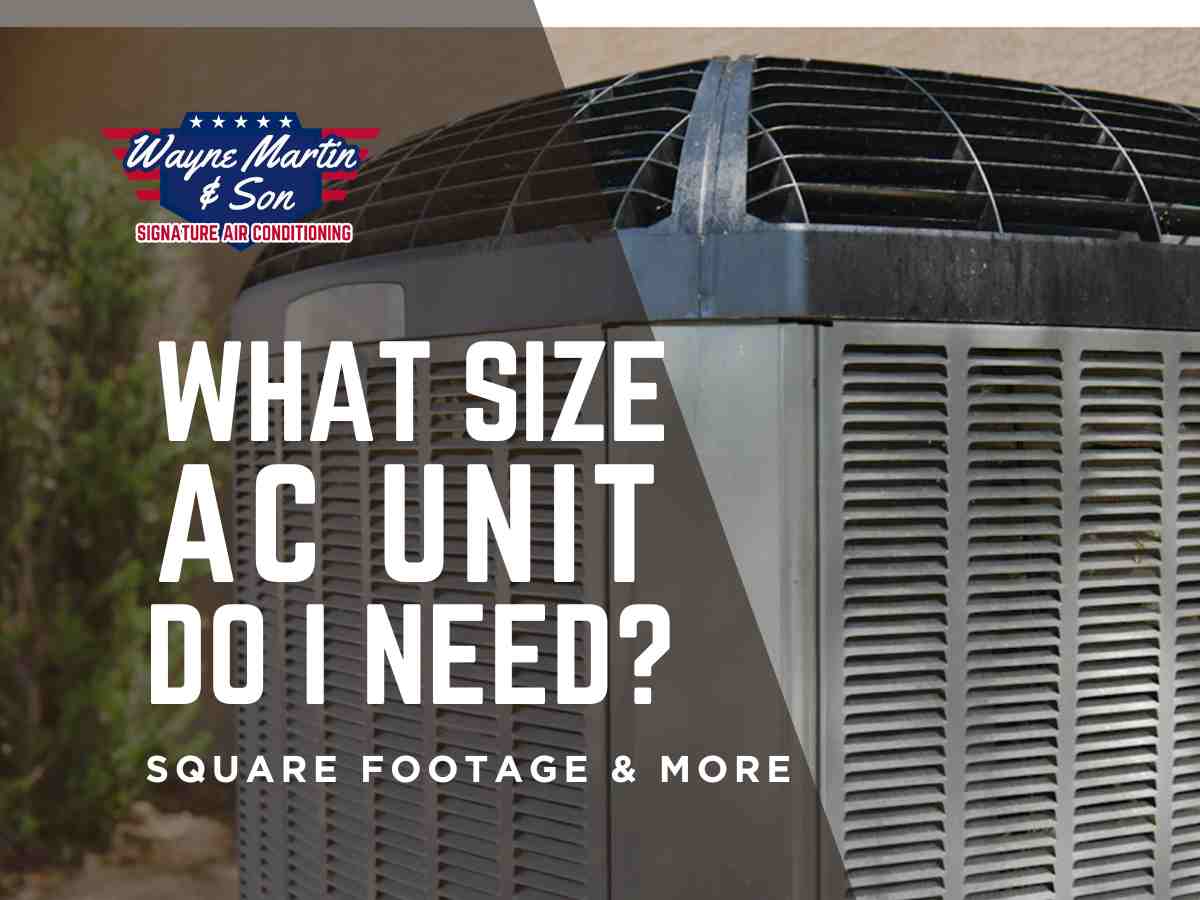What size air conditioner do I need? It’s one of the most common questions homeowners ask when they’re facing a replacement or new AC installation — and if you live in Southwest Florida, it’s even more important to get it right. Choosing the wrong size unit can lead to high energy bills, uneven temperatures, poor humidity control, and even premature system failure. So if you’re wondering what size air conditioner do I need in SWFL?, you’re in the right place.
We’re talking exclusively about central AC systems with outdoor condenser units — not window units or ductless mini-splits.
 What Size Air Conditioner Do I Need? Start With Square Footage
What Size Air Conditioner Do I Need? Start With Square Footage
The foundation of AC sizing is matching your home’s square footage with its cooling load. Cooling capacity is measured in BTUs (British Thermal Units).
Accurately estimating the required cooling load is critical to ensure your system maintains comfortable indoor temperatures without wasting energy or causing premature equipment wear. This is especially true in hot, humid climates like Southwest Florida, where factors such as high humidity, sun exposure, and building construction can significantly impact cooling needs.
The chart below reflects industry best practices for sizing central AC systems in hot-humid climates (like Florida’s Zone 1A), influenced by Florida Building Code climate zones and ACCA Manual J load calculation methodology.
| Home Size (sq ft) | Typical BTUs Needed | AC Tonnage |
|---|---|---|
| 1,000–1,200 | 24,000–30,000 | 2.0–2.5 |
| 1,300–1,500 | 30,000–36,000 | 2.5–3.0 |
| 1,600–1,800 | 36,000–42,000 | 3.0–3.5 |
| 1,900–2,100 | 42,000–48,000 | 3.5–4.0 |
| 2,200–2,400 | 48,000–54,000 | 4.0–4.5 |
| 2,500+ | 60,000+ | 5.0 |
What Size Air Conditioner Do I Need? Florida-Specific Sizing Factors
In Southwest Florida’s tropical climate, you can’t rely on square footage alone. Additional sizing factors include:
- Sun exposure: South-facing windows and dark roofs retain heat
- Insulation: Older block homes often lack adequate insulation
- Ceiling height: Vaulted ceilings increase air volume
- Duct location: Attic ducts can lose up to 30% of cooling without proper sealing
What Size Air Conditioner Do I Need? Don’t Forget SEER Ratings (Now SEER2)
What is SEER
SEER (Seasonal Energy Efficiency Ratio) measures how much cooling an air‑conditioner delivers for every watt‑hour of electricity it uses over an entire season. In short, the higher the SEER, the lower your power bill for the same amount of cooling.
While SEER does not determine the size of your unit, it significantly impacts your electricity costs and environmental footprint.
SEER vs. SEER2 (2023 Update)
Beginning January 1, 2023, the U.S. Department of Energy replaced the old SEER test with SEER2. The new method uses higher external static pressure to mimic real‑world ductwork, so SEER2 numbers look about 0.5–1 point lower than the old SEER ratings for the same unit.
Florida Code Minimums (Zone 1A)
If you live in Southwest Florida—you’re officially in Climate Zone 1A—the 2023 building code sets two simple baselines:
- 14.3 SEER2 for any new central AC up to about 3.5 tons (roughly 45,000 BTU and under).
- 13.8 SEER2 for larger systems (anything above 45,000 BTU).
Put another way: almost every homeowner shopping for a replacement unit in SWFL should start their search at 15 SEER2 or better. You’ll meet code, trim your FPL bill, and stay eligible for the most attractive utility rebates.
A bump from 14 to 16 SEER2 can slice 10‑15 % off annual cooling costs, which pays back the price difference in just a few summers.
What Size Air Conditioner Do I Need? Professional Load Calculation (Manual J)
To go beyond rule-of-thumb estimates, a professional HVAC contractor can run a Manual J Load Calculation.
A Manual J calculation is simply a professional measuring session—think of it as a home energy X‑ray. The contractor records your room sizes, window locations, insulation levels, and duct layout. The result is an accurate BTU target, so you’re not guessing or relying on rough charts.
Key data collected:
- Room‑by‑room square footage & ceiling height
- Window size, direction, and shading
- Insulation levels & air leaks
- Number of people and heat‑generating appliances
- Duct losses and attic temps
Why it matters: Getting the BTU target right can shave hundreds of dollars per year off your power bill and prevent premature system wear. The Air Conditioning Contractors of America (ACCA) call Manual J the gold standard for sizing.
BTU Per Square Foot: The Fast Sizing Shortcut
If you need a ballpark answer to “What size air conditioner do I need?”, just multiply your square footage by:
- 22 BTUs/sq ft for newer, insulated homes
- 25–30 BTUs/sq ft for older homes or poor ductwork
This method gives you a quick estimate, but it doesn’t account for real-world variables like roof exposure or duct loss — so use it with caution.
FAQ: What Size Air Conditioner Do I Need in SWFL?
What size air conditioner do I need for a 1,500 sq ft house?
3 tons (36,000 BTUs) is typical, but adjust for duct condition and insulation.
Should I oversize my AC “just in case”?
No — oversized systems short-cycle, increase humidity, and reduce system lifespan.
Does SEER affect the size I need?
Not directly. SEER affects efficiency, not capacity. You still need the correct tonnage.
What’s the safest way to know what size AC I need?
Request a Manual J Load Calculation from a licensed Florida HVAC contractor.
Final Thoughts: Ready to Size Your Next AC?
If you’ve been asking “What size air conditioner do I need?”, you know by now that square footage is only part of the equation. In Southwest Florida, proper sizing also means accounting for humidity, insulation, ductwork, and sun‑soaked roofs.
Here’s your next move:
- Check the chart. Use the BTU‑per‑square‑foot table above to get a quick idea of your cooling load.
- Call our professional team. We’ll confirm your numbers, explain your best‑fit options, and show you real energy‑savings comparisons—no jargon, just clear answers.
- Pick 15 SEER² or higher. You’ll beat Florida code, lower your power bill, and stay rebate‑eligible.
Ready for a cooler, drier home? Call us for a free in‑home estimate.
You’ll get an honest assessment, upfront pricing, and a perfect‑fit system—installed by Florida‑licensed professionals who stand behind their work!

